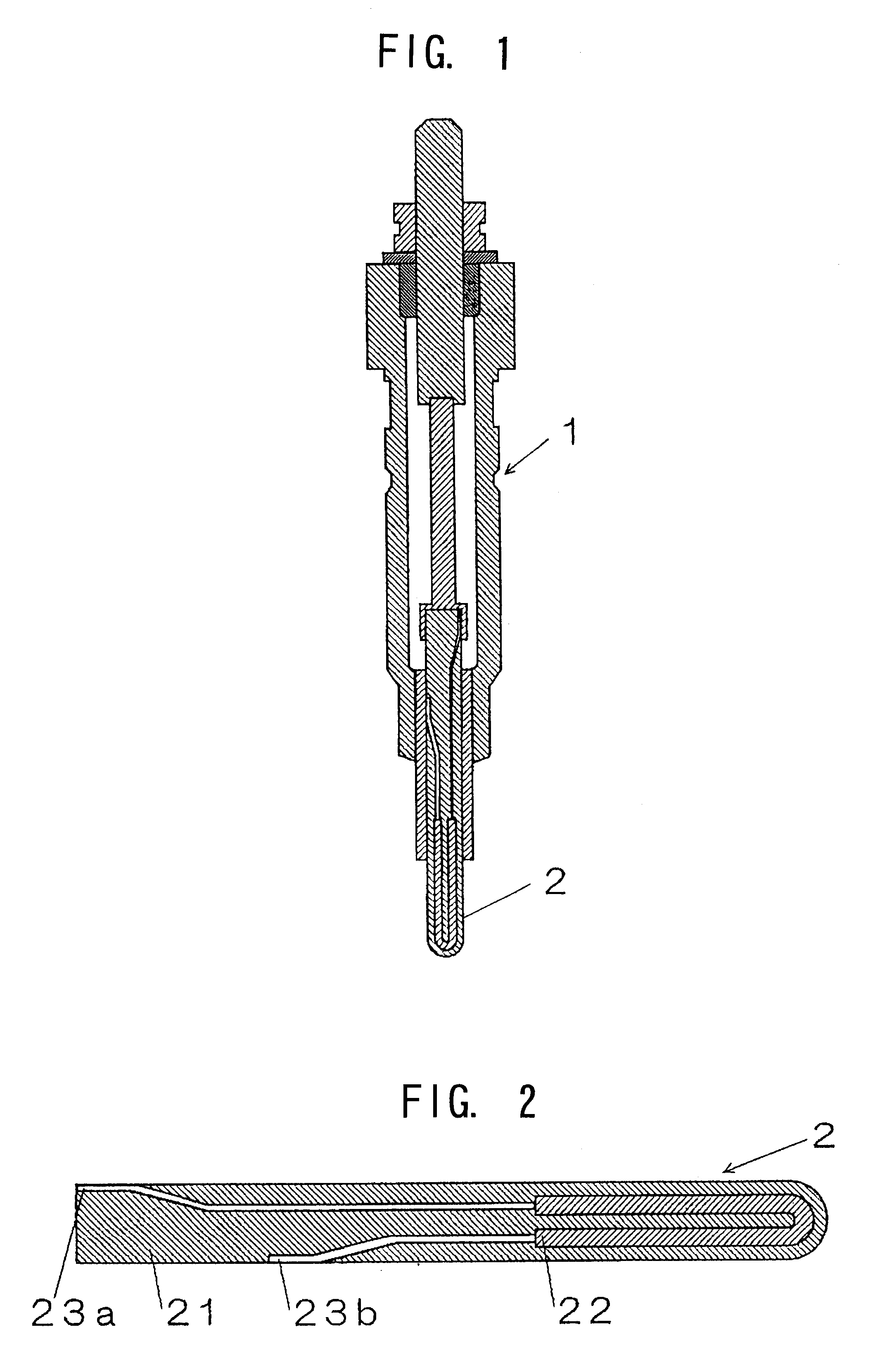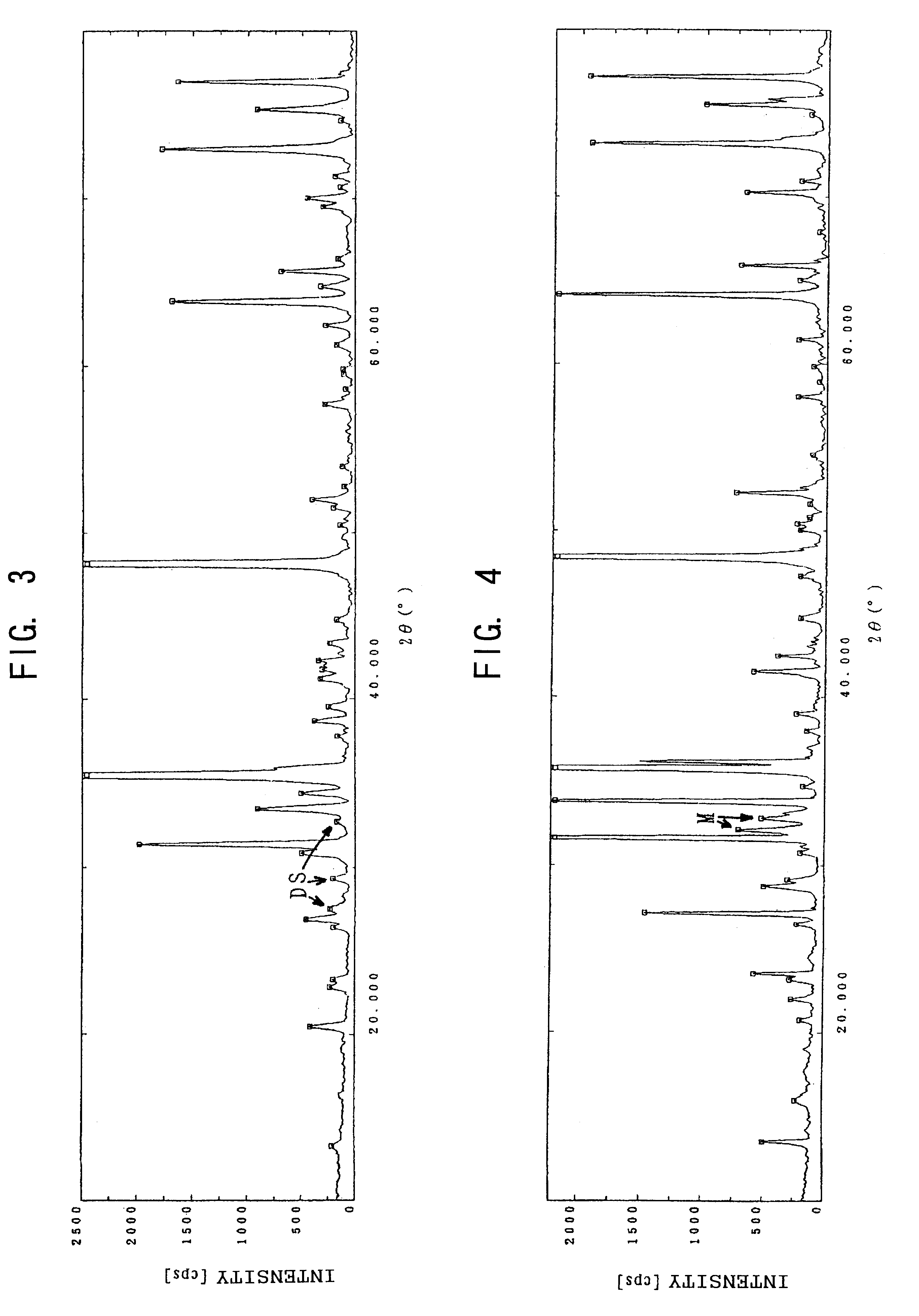The aforementioned sintered compact having
melilite in grain boundaries has excellent
mechanical strength at high temperature, but involves disadvantages in that oxidation tends to occur at relatively low temperature and that
cracking may arise from
volume expansion.
As a result, even when such a
crystal phase is precipitated in a heating resistor which contains a conductive component, the vitreous substance conceivably causes impairment in working durability.
The remaining glass phase impairs
mechanical strength at high temperature and working durability of a heating resistor and a ceramic heater using the heating resistor.
Particularly, in the case of a high-temperature-type
glow plug, which involves a temperature rise to 1500.degree. C. or higher at a certain portion thereof, a heater may break due to impairment in strength, or a heating resistor may break due to
decomposition of the glass phase in grain boundaries caused by a
potential difference induced during application of
electricity.
However, the method fails to solve the problem sufficiently.
When RE.sub.2 O.sub.3 is contained in the
silicon nitride ceramic in an amount of less than 1 mol %, the
silicon nitride ceramic encounters difficulty in densification.
In contrast, when RE.sub.2 O.sub.3 is contained in excess of 6 mol %, even when the SiO.sub.2 / RE.sub.2 O.sub.3 ratio falls within the preferred range, the
mechanical strength tends to be impaired.
Particularly, in the case of application to a member of a ceramic heater, the durability at high temperature is impaired.
When the SiO.sub.2 / RE.sub.2 O.sub.3 ratio is less than 1, particularly in the case of RE.sub.2 O.sub.3 being contained in a small amount, the strength and working durability are impaired greatly in application to, for example, a ceramic heater.
In contrast, when the SiO.sub.2 / RE.sub.2 O.sub.3 ratio is in excess of 5, the durability at high temperature tends to be impaired.
However, as mentioned above, the melilite is likely to be oxidized at low temperature.
When RE.sub.2 O.sub.3 is contained in the
silicon nitride ceramic in an amount of less than 1 mol %, the
silicon nitride ceramic encounters difficulty in densification.
In contrast, when RE.sub.2 O.sub.3 is contained in excess of 6 mol %, even when the SiO.sub.2 / RE.sub.2 O.sub.3 ratio falls within the preferred range, the mechanical strength tends to be impaired.
When the SiO.sub.2 / RE.sub.2 O.sub.3 ratio is less than 2, particularly in the case of RE.sub.2 O.sub.3 being contained in a small amount, strength and working durability are impaired greatly in application to, for example, a ceramic heater.
By contrast, when the SiO.sub.2 / RE.sub.2 O.sub.3 ratio is in excess of 5, durability at high temperature tends to be impaired.
When a crystal phase serving as the predominant phase of the conductive
silicon nitride ceramic other than the conductive component and the silicon nitride has a
melting point lower than 1600.degree. C., the
resultant heating resistor fails to have
high heat resistance.
A ceramic heater having such a heating resistor embedded therein fails to exhibit sufficient mechanical strength at high temperature, and working durability thereof is impaired.
When RE.sub.2 O.sub.3 is contained in the silicon nitride ceramic in an amount of less than 1 mol %, the
resultant conductive silicon nitride ceramic encounters difficulty in densification with a
resultant impairment in mechanical strength and durability, thus failing to provide a heating resistor applicable to practical use.
In contrast, when RE.sub.2 O.sub.3 is contained in excess of 6 mol %, the mechanical strength tends to be impaired, and the durability is impaired.
As a result, the mechanical strength and durability tend to be impaired.
When RE.sub.2 O.sub.3 is contained in the silicon nitride ceramic in an amount of less than 1 mol %, the resultant conductive silicon nitride ceramic encounters difficulty in densification with a resultant impairment in mechanical strength and durability, thus failing to provide a heating resistor applicable to
actual use.
In contrast, when RE.sub.2 O.sub.3 is contained in excess of 6 mol %, the mechanical strength tends to be impaired, and the durability is impaired.
When the SiO.sub.2 / RE.sub.2 O.sub.3 ratio is less than 1, particularly in the case of RE.sub.2 O.sub.3 being contained in a small amount, the strength and working durability are impaired greatly.
In the case of Example 1, in which the Er.sub.2 O.sub.3 content is excessively low, densification is not sufficiently established, and the bending strength and durability are both impaired greatly.
Particularly, the bending strength is impaired with the SiO.sub.2 / Er.sub.2 O.sub.3 ratio, and the durability is impaired greatly with the SiO.sub.2 / Er.sub.2 O.sub.3 ratio.
In the case of Example 16, in which the Er.sub.2 O.sub.3 content is excessively high and the SiO.sub.2 / Er.sub.2 O.sub.3 ratio is high, the bending strength and durability are both impaired greatly.
 Login to View More
Login to View More 


